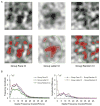Seeing Jesus in toast: neural and behavioral correlates of face pareidolia
- PMID: 24583223
- PMCID: PMC3980010
- DOI: 10.1016/j.cortex.2014.01.013
Seeing Jesus in toast: neural and behavioral correlates of face pareidolia
Abstract
Face pareidolia is the illusory perception of non-existent faces. The present study, for the first time, contrasted behavioral and neural responses of face pareidolia with those of letter pareidolia to explore face-specific behavioral and neural responses during illusory face processing. Participants were shown pure-noise images but were led to believe that 50% of them contained either faces or letters; they reported seeing faces or letters illusorily 34% and 38% of the time, respectively. The right fusiform face area (rFFA) showed a specific response when participants "saw" faces as opposed to letters in the pure-noise images. Behavioral responses during face pareidolia produced a classification image (CI) that resembled a face, whereas those during letter pareidolia produced a CI that was letter-like. Further, the extent to which such behavioral CIs resembled faces was directly related to the level of face-specific activations in the rFFA. This finding suggests that the rFFA plays a specific role not only in processing of real faces but also in illusory face perception, perhaps serving to facilitate the interaction between bottom-up information from the primary visual cortex and top-down signals from the prefrontal cortex (PFC). Whole brain analyses revealed a network specialized in face pareidolia, including both the frontal and occipitotemporal regions. Our findings suggest that human face processing has a strong top-down component whereby sensory input with even the slightest suggestion of a face can result in the interpretation of a face.
Keywords: Face pareidolia; Face processing; Fusiform face area; Top-down processing; fMRI.
Copyright © 2014 Elsevier Ltd. All rights reserved.
Figures









References
-
- Brett M, Anton J, Valabregue R, Poline J. Region of interest analysis using an SPM toolbox [abstract]. The 8th International Conference on Functional Mapping of the Human Brain; Sendai, Japan. 2002. Available on CD-ROM in NeuroImage.
-
- Chauvin A, Worsley KJ, Schyns PG, Arguin M, Gosselin F. Accurate statistical tests for smooth classification images. Journal of Vision. 2005;5(9):659–667. - PubMed
-
- Curtis CE, D’Esposito M. Persistent activity in the prefrontal cortex during working memory. Trends in Cognitive Sciences. 2003;7(9):415–423. - PubMed
-
- Devue C, Collette F, Balteau E, Degueldre C, Luxen A, Maquet P, et al. Here I am: The cortical correlates of visual self-recognition. Brain Research. 2007;1143:169–182. - PubMed
Publication types
MeSH terms
Grants and funding
LinkOut - more resources
Full Text Sources
Other Literature Sources
Miscellaneous

